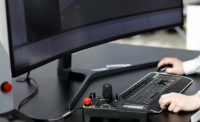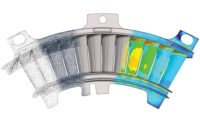Software & Analysis
Reverse Engineering Software For 3D
Once the model has been generated, you can use the software to analyze the model.

Motorcycle frame points-to mesh-to surfaces. Source: Exact Metrology
Reverse engineering software for 3D scanning enables users to create a three-dimensional model of an object by using a 3D scanner. This type of software is commonly used by engineers, scientists, and other professionals for a wide range of applications. Reverse engineering software for 3D scanning can be used to accurately measure and analyze the geometry of complex objects. In this guide, we will explain how to use reverse engineering software for 3D scanning.
Step 1:
Before you can begin reverse engineering for 3D scanning, you need to choose the appropriate software for the job. There are many different types of software available for 3D scanning and reverse engineering projects. Determine the format of your 3D scan data. You will need to know if your scan data is in a point cloud, mesh, or CAD format. This will help you determine which software is best suited for your needs. Consider the features you need. Different software packages offer different features, so it’s important to consider which ones you need for your project. Do you need automated surface reconstruction, mesh editing, or CAD model generation? Once you have an idea of the features you need, look at the different software packages available and compare them to determine which one is the best fit for your project. Also, consider the cost. Depending on your project, cost may be an important factor to consider when choosing the right software.
Step 2:
Set up the 3D scanner. Once you have chosen the appropriate software, you will need to set up the 3D scanner. This involves connecting the scanner to your computer, calibrating the scanner, and setting up the scanning parameters. A critical setting that helps drive the success of the following steps is resolution. The resolution of the 3D scanner will determine the accuracy and detail of the 3D scan. Scanning speed is also a factor. How fast the 3D scanner can capture data is important when determining the total time it will take to complete a scan.
Step 3:
Once you have set up the 3D scanner, you can begin scanning the object.
Move the 3D scanner slowly and steadily across the surface of the object. Make sure to capture all of the details of the object. Depending on the type of outputs required, this process may not require 100% of the object to be scanned. For instance, a fan with a central hub. Only one blade may need to be captured in fine detail, and patterned during the modeling process. Pay attention to patterns and symmetry. Inversely, if handling complex sculptural details, all that geometry would need to be captured to be modeled in its entirety.
Step 4:
Once the scan is complete, the data will need to be processed. The software will use the scanned data to create a three-dimensional model of the object. This process can take several minutes, depending on the size and complexity of the object. This first initial stage is a polygon model, consisting of all the 3D data points connected by triangular facets, commonly referred to as a ‘mesh.’ This stage also includes editing the mesh to prepare it for the next stage. Correcting small anomalies like gaps in the mesh, or deleting fixturing that may have been captured during the scanning stage.
Step 5:
With the scan data cleaned and ready for modeling, the determination needs to be made on what type of modeling best fits the geometry that was scanned. Two common methods are NURBS and CAD, or feature-based, modeling. NURBS (Non-Uniform Rational B-Spline) is a mathematical model which is used to represent and manipulate 3D curves and surfaces. It is often used to capture highly complex and more organic-shaped features or general shapes of objects where traditional CAD modeling is not required. CAD (Computer Aided Design) models are used to create 3D models of existing objects typically associated with software such as Solidworks, or Creo. There are specific reverse engineering softwares that can handle large data, and emulate the same CAD approach as those traditional software packages. Applying sketch-driven features allows for model correction and preparation for future processes. This is a typical output requirement for engineering and manufacturing environments.
Step 6:
Once the model has been generated, you can use the software to analyze the model. The software can be used to measure distances, angles, and other properties of the object. Although some software has the capability to dynamically evaluate as the model is being created, this is a good practice to assure all features have been captured within the requirements of the project.
Looking for a reprint of this article?
From high-res PDFs to custom plaques, order your copy today!





